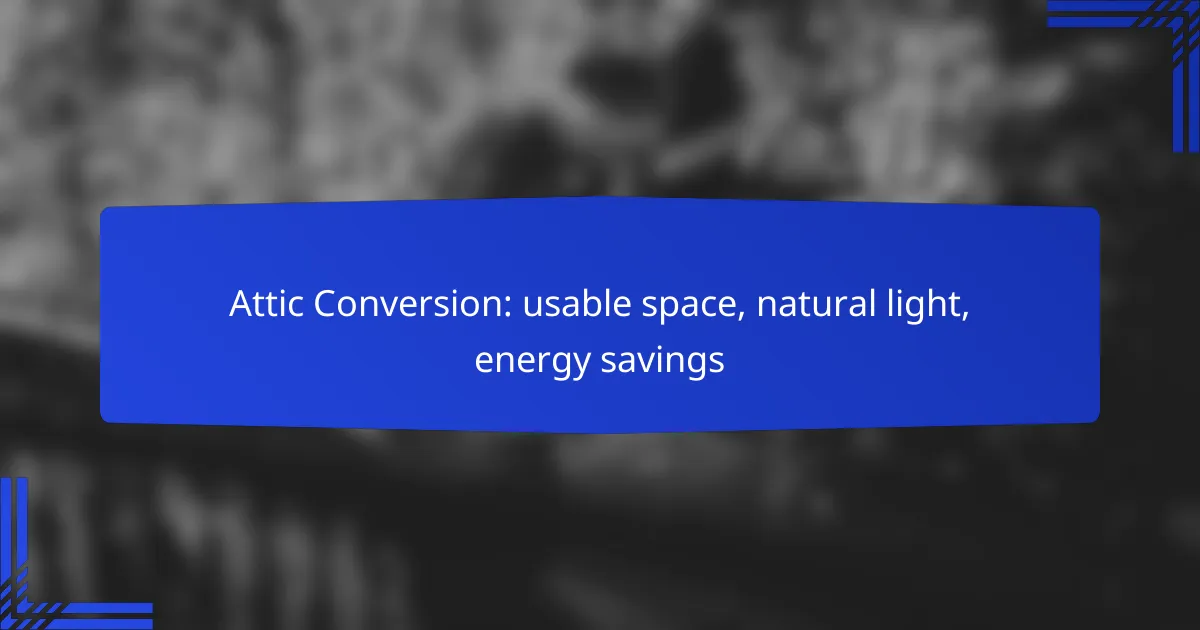An attic conversion offers a fantastic opportunity to maximize usable space in your home, turning an often-overlooked area into functional and valuable rooms. By incorporating windows or skylights, these conversions not only enhance natural light but also promote energy efficiency, leading to significant savings on heating costs. This transformation not only improves your living environment but also adds value to your property, making it a smart investment for homeowners.

How can an attic conversion create usable space in London homes?
An attic conversion can significantly enhance the usable space in London homes by transforming an underutilized area into functional rooms. This process not only increases living space but can also add value to the property, making it a worthwhile investment for homeowners.
Maximizing floor area
To maximize floor area in an attic conversion, consider the layout and design. Open-plan designs can create a sense of spaciousness, while careful placement of walls and furniture can optimize usable space. It’s essential to comply with local building regulations, which may dictate minimum ceiling heights and structural requirements.
Utilizing built-in storage solutions can further enhance floor area. Custom shelves and cabinets can help keep the space organized without sacrificing valuable square footage.
Creating additional bedrooms
Converting an attic into additional bedrooms is a popular choice for families needing more space. This option can provide a private sleeping area for children or guests, enhancing the home’s functionality. Ensure that the new bedrooms meet local building codes, including proper egress windows for safety.
Consider the layout to maximize comfort and privacy. Adding en-suite bathrooms can also increase the appeal of these new bedrooms, making them more attractive to potential buyers.
Transforming into a home office
Transforming an attic into a home office can create a quiet, dedicated workspace away from the main living areas. This setup is particularly beneficial for remote workers seeking a distraction-free environment. Good lighting and ventilation are crucial, so consider adding skylights or dormer windows to enhance natural light.
When designing a home office in the attic, prioritize ergonomics and functionality. Ensure there is adequate electrical access for equipment and consider soundproofing options if the space is near noisy areas of the house.

What are the benefits of natural light in attic conversions?
Natural light in attic conversions enhances the usability of the space while promoting well-being and energy efficiency. By incorporating windows or skylights, homeowners can create a brighter, more inviting environment that reduces reliance on artificial lighting.
Improved mood and productivity
Natural light has a significant impact on mood and productivity. Exposure to sunlight can boost serotonin levels, leading to improved mental health and increased focus. In an attic conversion, strategically placed windows can maximize sunlight exposure, creating a workspace that fosters creativity and efficiency.
To optimize natural light, consider the orientation of your windows. South-facing windows typically receive the most sunlight throughout the day, making them ideal for enhancing mood and productivity.
Enhanced aesthetic appeal
Incorporating natural light into attic conversions enhances the aesthetic appeal of the space. Sunlight can highlight architectural features and create a warm, inviting atmosphere. Large windows or skylights can transform a previously dark area into a bright, open environment.
When designing your attic conversion, think about how natural light interacts with colors and materials. Light-colored walls and reflective surfaces can amplify the brightness, making the space feel larger and more welcoming.
Energy efficiency through daylight
Utilizing natural light in attic conversions can lead to significant energy savings. By reducing the need for artificial lighting during the day, homeowners can lower electricity bills. Additionally, well-placed windows can enhance ventilation, reducing the need for air conditioning in warmer months.
Consider installing energy-efficient windows with good insulation properties. Look for options that meet local energy standards, which can further enhance your attic’s energy efficiency and comfort throughout the year.

How does an attic conversion contribute to energy savings?
An attic conversion can significantly enhance energy savings by improving insulation and reducing heating costs. By transforming an unused space into a livable area, homeowners can optimize their energy efficiency and lower utility bills.
Improved insulation
One of the primary benefits of an attic conversion is the opportunity to install high-quality insulation. Proper insulation minimizes heat loss during winter and keeps the space cool in summer, leading to a more stable indoor temperature.
Using materials like spray foam or fiberglass can help achieve an R-value that meets or exceeds local building codes. This not only enhances comfort but also reduces the workload on heating and cooling systems.
Reduced heating costs
With improved insulation, homeowners can expect lower heating costs. A well-insulated attic can reduce energy consumption by preventing warm air from escaping, which is especially beneficial in colder climates.
For example, many homeowners report savings of 20-30% on their heating bills after completing an attic conversion. This reduction can lead to a quick return on investment, especially in regions with harsh winters.
Increased property value
An attic conversion not only saves energy but also increases property value. A well-designed attic space can attract buyers looking for additional living areas, making the home more marketable.
In many markets, the return on investment for attic conversions can be substantial, often recouping a significant portion of the renovation costs. This added value can be particularly advantageous in competitive real estate markets.

What are the key considerations before starting an attic conversion?
Before beginning an attic conversion, it’s essential to evaluate building regulations, structural integrity, and budget planning. These factors ensure the project is feasible, safe, and financially viable.
Building regulations in the UK
In the UK, attic conversions must comply with local building regulations, which cover safety, energy efficiency, and structural integrity. It’s crucial to obtain the necessary permissions from your local council, as failing to do so can lead to fines or the need to reverse the conversion.
Common regulations include fire safety measures, insulation standards, and access requirements. Consulting with a professional can help navigate these regulations effectively.
Structural integrity assessments
Assessing the structural integrity of your attic is vital to ensure it can support the additional weight and usage. This typically involves evaluating the existing beams, joists, and roof structure.
A qualified structural engineer can conduct an assessment and recommend any necessary reinforcements. Ignoring this step can lead to safety hazards and costly repairs later on.
Budget planning and financing
Budget planning is a critical aspect of an attic conversion, as costs can vary widely based on the scope of work. On average, conversions can range from several thousand to tens of thousands of pounds, depending on factors like design complexity and materials used.
Consider financing options such as home improvement loans or remortgaging to cover expenses. It’s advisable to create a detailed budget that includes all potential costs, including labor, materials, and permits, to avoid unexpected financial strain.

What design options are available for attic conversions?
Attic conversions can be tailored to maximize usable space, enhance natural light, and improve energy efficiency. Key design options include the installation of Velux windows, open-plan layouts, and smart storage solutions.
Velux windows for natural light
Velux windows are an excellent choice for bringing natural light into attic spaces. These roof windows can significantly brighten up the area, making it feel more open and inviting. Consider placing them strategically to capture sunlight throughout the day.
When selecting Velux windows, think about the size and placement. Larger windows can provide more light but may require additional structural support. Ensure that the windows comply with local building regulations regarding size and placement to avoid potential issues.
Open-plan layouts
Open-plan layouts in attic conversions create a spacious feel and enhance functionality. By removing unnecessary walls, you can create a versatile area that can serve multiple purposes, such as a bedroom, office, or playroom.
When designing an open-plan space, consider the flow of movement and how each area will be used. Use furniture to define different zones without the need for physical barriers. This approach not only maximizes space but also encourages a more social environment.
Storage solutions
Effective storage solutions are crucial in attic conversions to maintain a clutter-free environment. Built-in shelves, under-eave storage, and multi-functional furniture can help utilize every inch of available space efficiently.
Consider custom cabinetry that fits the unique dimensions of your attic. This can provide ample storage while blending seamlessly with the overall design. Avoid overcrowding the space with too much furniture; instead, focus on a few key pieces that offer both style and functionality.

How can homeowners in the UK choose a contractor for attic conversions?
Homeowners in the UK can choose a contractor for attic conversions by carefully evaluating qualifications, comparing quotes, and understanding warranties. Selecting the right contractor ensures a successful project that meets budget and quality expectations.
Checking qualifications and reviews
Start by verifying the contractor’s qualifications, including relevant certifications and experience in attic conversions. Look for contractors who are members of recognized trade associations, such as the Federation of Master Builders or the National Federation of Builders.
Reviews from previous clients provide insight into the contractor’s reliability and quality of work. Websites like Trustpilot or Checkatrade can help you gauge customer satisfaction and identify any recurring issues.
Comparing quotes and timelines
When comparing quotes, ensure they include a detailed breakdown of costs, such as materials, labor, and any additional fees. This transparency helps you make informed decisions and avoid unexpected expenses.
Consider the timelines provided by different contractors. A reasonable attic conversion project may take anywhere from a few weeks to a couple of months, depending on complexity. Ensure that the contractor can meet your schedule without compromising quality.
Understanding warranties and guarantees
Warranties and guarantees are crucial when selecting a contractor for attic conversions. A good contractor should offer a warranty on their workmanship, typically ranging from one to ten years, depending on the scope of the project.
Additionally, inquire about manufacturer warranties for materials used in the conversion. Understanding these guarantees can protect your investment and provide peace of mind in case of future issues.
